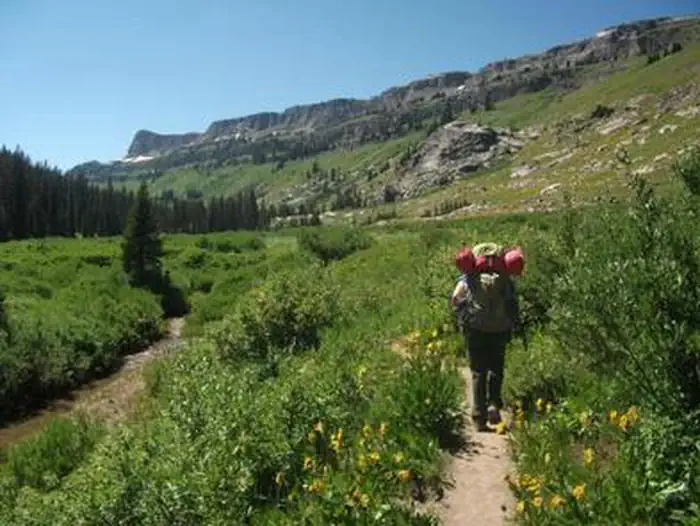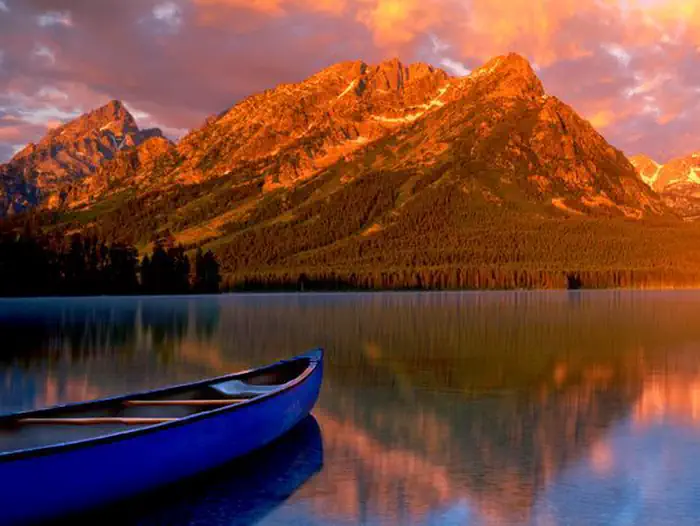Grand Teton National Park Backcountry Permits
Over 230 miles of breathtaking mountain trails, high-alpine camping zones, lakeshore and boat-in sites, and climbing bivy sites await the mountain adventurer. Some of the most impressive mountain wilderness in the world is found in Grand Teton National Park - pristine alpine meadows blanketed with wildflowers, crystal clear lakes and streams, glacially carved canyons, towering granite peaks and abundant wildlife. The area is typified by rugged peaks and dramatic canyons ranging from 6,700 feet to 13,770 feet in elevation. Planning Your Backcountry Trip prior to backountry camping is key to a successful trip.
- Backcountry Camping Permits are required for all overnight stays in the backcountry, whether the destination is a site on lakeshore site on Jackson Lake or Leigh Lake, a multi-day Teton Crest Trail (TCT) in the Mountain Camping zone, a Technical Climbing/Garnet Canyon area site, or exploring the remote Northern Canyons.
- Most trails gain elevation quickly and many cross steep mountain passes. Snow and ice can remain on designated trails and passes well into July requiring specialized gear such as ice axes/crampons and having experience using that gear. Falls can be consequential. Have all group members watch the safety video before heading out. Backcountry Safety Video
- Be sure to research your trip itinerary thoroughly to understand the backcountry camping routes and zones before you attempt to reserve your trip. Some camping zones fill quickly. Have alternate itineraries or contingency plans if your preferred trip is not available.
- Map out your trip using point to point mileage map you can download or the new interactive map of backcountry camping zones and sites which provides details to plan your trip.
- Topographical maps and books describing the trails are available for purchase at the Grand Teton Association website.
- When planning a backcountry camping trip in Grand Teton National Park, backpackers should expect to travel no more than 2 miles per hour (3.2 km per hour). Add an additional hour for every 1,000 feet of elevation gain. Trip planning that requires going over more than one pass in a day is not recommended.
Notifications and Alerts
Death Canyon Trailhead will be closed for the 2026 summer season for construction. All camping zones will remain open but may need to be accessed through alternate routes.
Permit & Season Information
All persons who intend to sleep overnight, camp, or bivouac in the backcountry of Grand Teton National Park, or who are in possession of equipment designed for overnight use in the backcountry, must obtain a backcountry camping permit and carry it with them.
- Backcountry permits are limited to minimize damage to the resource.
- One backcountry permit allows for up to 10 consecutive nights of stay within Grand Teton Park's backcountry, and 10 nights total during the summer.
- One-third of all backcountry campsites and all of the group sites may be reserved in advance, online, beginning January 10, up until 2 days before the trip begins.
- The remaining sites are filled on a first-come, first-served basis in person at park permit offices no more than one day before the trip begins.
- The permit is valid only for the number of people, dates and locations indicated.
- Campers must use all nights on a permit for the permit to remain valid.
- For more information Backcountry Camping FAQs
Need to Know
One permit can include up to 10 consecutive nights of stay in multiple campsite zones. Once you have determined the areas you would like to visit during your backcountry trip you will need to reserve a campsite for each night.
Early Season Snow Conditions
Snow usually melts from valley trails, approximately 6,700 feet by mid-June but remains in parts of the high country through much of the summer. Safe travel over Paintbrush, Static Peak and Moose Basin Divides, and Hurricane, Mt. Meek and Fox Creek Passes requires an ice axe and knowledge of its use as late as August. Snow conditions vary from year to year. If you are planning to cross any divides before late July, and do not have the skills for safe use of an ice axe on steep snowfields, consider an alternate route. Crossing a divide or pass is essential when traveling on the Teton Crest Trail and for loop trips. However, there are still opportunities for a rewarding "in and out" trip utilizing any of the major canyons.
Mountaineering
Permits are not required for mountaineering, but climbers on overnight trips must have a backcountry permit to camp or bivouac. Weather can be extreme and change rapidly, impacting climbing trips to the Teton Range. It's important to check current local weather and mountain conditions prior to your visit. We encourage climbers to pack out what they pack in including packing out human waste from this fragile alpine environment. Bags are made available to those who are camping at the Lower Saddle and the Caves campsites.
Bear Country
All backcountry campers are required to carry Interagency Grizzly Bear Committee approved bear canisters unless a bear proof metal box is installed at the campsite. Canisters can be checked out at all permit issuing stations free of charge with a backcountry permit. Learn more about Interagency Grizzly Bear Committee approved portable bear resistant food canisters.
Planning
Backcountry Safety Video to help prepare for backcountry travel in Grand Teton National Park.
The Grand Teton backcountry is organized into zones and sites--Backcountry Camping Areas In planning your trip, decide how far is reasonable for all your group members to hike each day, keeping in mind elevation changes. Plot this out using the Backcountry Planning Map and “point to point” mileage information on the map. When you select a campsite from the Mountain Camping Zones (campsites higher in elevation and further hiking mileage to get to) area you are permitted to camp anywhere inside that zone. View maps of the Mountain Camping Zones Mountain Camping Zones. Sel ecting individual sites, such as from the lower elevation Jackson or Leigh Lakes areas, offers specific designated camping spots which can be accessed by boat or some by a short hike. These are marked by a sign and have tent pads.
Large groups may not split into smaller groups and camp in the same zone together. Permits are subject to review and violations may result in the permit being revoked.
Fee Policy
Permit Fee
- Permit Fee: $20 per permit (non-refundable)
- Nightly Fee: $7 per person (refundable until 5 days before permit start-date)
Cancellation Policy
Change Policy:
- You may make changes to your permit itinerary (campsite locations, nights, group size), if space is available, up to 2 days before the start of your trip. Or, the permit ranger may make changes starting one day prior to your permit start date.
- If you add nights or increase the group size, you will be charged for the additonal nightly per-person fee.
- You may not change the start date of your trip.
Cancellation/Refund Policy:
- Reservations cancelled 5 or more full days before the reservation start date receive a full refund of the nightly per-person fee.
- Reservations cancelled 5 or less days before the reservation start date are non-refundable.
- Modifying the reservation by lowering the the group size or reducing the number of nights at least 5 or more days before the start date will also result in a refund of the nightly per-person fee.
- The $20 permit fee is non-refundable.
Contact Information
Mailing Address
P.O. Box 170 Moose WY 83012
Phone Number
307-739-3309







